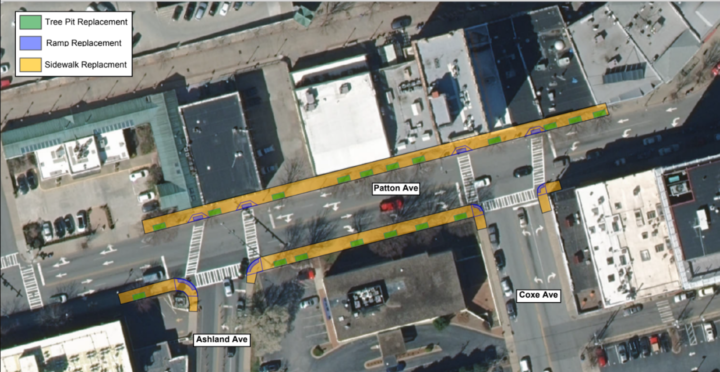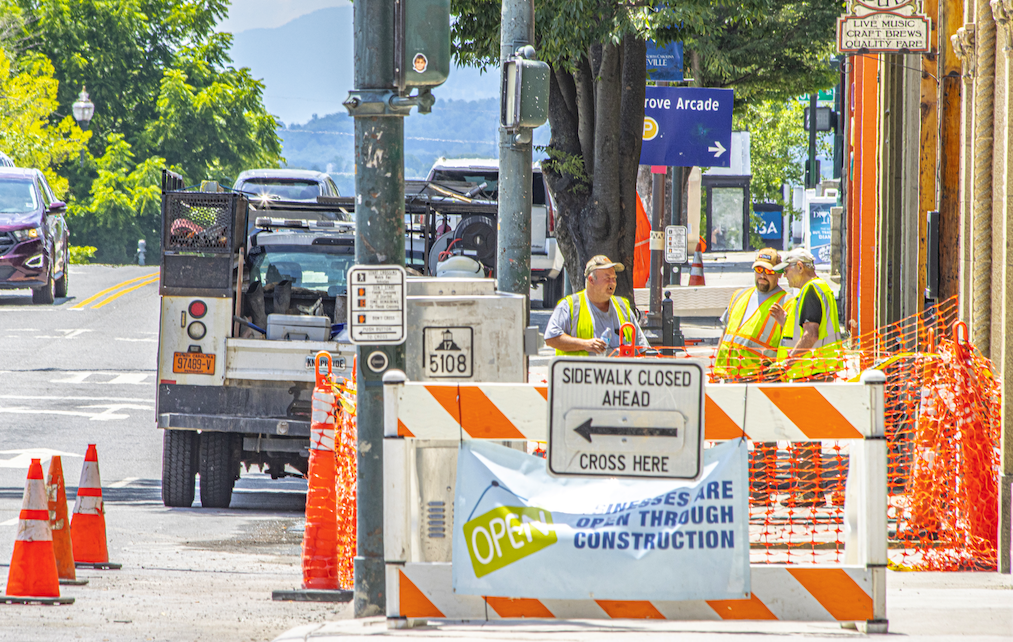Over the last few months, orange construction fences have gone up while 18 trees have gone down along a short stretch of Patton Avenue between Asheland and Coxe avenues. The sidewalk project is part of the City of Asheville’s long-term plan to make pedestrian walkways compliant with the Americans with Disabilities Act (ADA).
Advocates for the disabled say the changes are a small but welcome step toward improving accessibility throughout the city for people who use wheelchairs, walkers or canes. But some business owners in the area are angry that the city decided to do the construction during the height of the summer tourist season and question whether it is necessary at all.
“The sidewalks were not damaged, they were perfectly fine,” says Annabel Eckert, co-owner of Jack of the Wood Pub. “There’s a million other things the city could be spending money on. The potholes are terrible. It’s a little comical.”
City officials are sympathetic to the concerns of Eckert and other merchants and say they have tried to minimize disruptions. “This is a busy time of year for businesses, whether it’s restaurants, bars or otherwise,” says Chad Bandy, the city’s streets division manager. “We work as closely with their schedules as we possibly can because we do know those are real impacts that affect people’s livelihoods.”
But the work needs to be done, he says. The section of Patton Avenue under construction was identified as a top priority project for ADA compliance in the GAP Plan adopted by City Council in 2022. The GAP Plan, which aims to increase the connectivity of greenways, improve sidewalks and bike lanes, and make public walkways friendlier for disabled residents, includes an updated ADA Transition Plan.
The city’s original transition plan was adopted in the early 1990s, not long after the ADA became law. But like most American cities, Asheville has fallen far behind in terms of sidewalk compliance. According to a 2020 study in The International Journal of Urban Policy and Planning, 65% of curb ramps and 48% of sidewalks nationally were not accessible for people with disabilities.
The GAP’s ADA transition component calls for 25% of the city’s accessibility features to be ADA-compliant to the maximum extent feasible after 10 years. After 20 years, the figure is 50%; after 30 years, 75%; and after 40 years, 100%.
“We didn’t get in bad shape overnight, we won’t get out of bad shape overnight with [ADA compliance], but we are trying to be intentional about working on these compliance issues,” he says.
The Asheville Downtown Association identified 22 problems with the sidewalks on Patton Avenue between Asheland and Coxe avenues, including trip hazards caused by buckling pavement and bulging tree roots. Additionally, several noncompliant curb ramps must be replaced, and one must be built for ADA compliance.
Done by September
In October, City Council authorized $300,000 in federal Community Development Block Grant (CDBG) funding for the improvements. The city’s original plan called for the project to begin in November and be done by April, before summer tourism season. “We were hoping to do the concrete work over the winter, and then plant the trees this spring,” Bandy says. “But there were various delays, which is common with federal grants.”
As a result, the work didn’t begin until May 20 with a scheduled completion date of September. The city is waiting until October to plant the new trees, a mix of ginkgos, black gum trees and little-leaf lindens because fall is a better time for planting than summer, Bandy says.
The construction started on the sidewalk in front of 81 Patton Ave. and is proceeding westward until it gets to the front of 115 Patton Ave. Work is being done Mondays-Thursdays, 7 a.m.-5 p.m., weather permitting, with sidewalk closures coordinated to minimize disruption to businesses, he says. For instance, Thirsty Monk at 92 Patton Ave. is closed Mondays-Wednesdays, so crews have concentrated their work in front of the pub on those days.
In addition to one-on-one contact with business owners, the city held meetings and public hearings for affected stakeholders. And officials regularly update the project’s progress on a dedicated webpage.

But not every business owner is satisfied.
Kate Burkhead, owner of Sonora Cocina Mexicana at 89 Patton Ave., says city officials met with some merchants when the construction first was scheduled to start in November. But after that, she didn’t hear anything until February.
“Trying to talk to anybody about anything has been extremely difficult,” she says. “They tell everybody a different thing. As far as the city is concerned, there is absolutely no communication from them whatsoever.”
She says her access to the business hasn’t been hurt much because the city was able to do the work in the area in front of her restaurant during a week it was closed. Still, she says, the construction has had a negative effect. “The cones and signs everywhere at the beginning of downtown are such a deterrent for everyone to come to enjoy everything that’s down here.”
And, she says, the lack of trees had made her building hotter and increased her air-conditioning expenses.
“The lack of consideration is absolutely mind-boggling,” she says.
Eckert, co-owner of Jack of the Wood, similarly is not happy with how the city has handled the removal of the 18 trees. City officials say the trees needed to be removed because bulging tree roots caused the sidewalks to buckle, creating tripping hazards and limiting accessibility.
“They made the street really charming and cute with a much nicer ambiance,” she says. “The city did this without proper planning to time it where they could replant and do something to keep downtown looking beautiful. It’s just beyond me that they chose to do this in the middle of summer instead of in January or the fall when Asheville’s slower.”
But city officials say they opted not to wait until the fall because a survey of the Asheville Downtown Association indicated merchants didn’t want the work to interfere with the leaf and holiday seasons. Additionally, they say, summer is the best time for concrete construction work due to weather conditions.
Xpress reached out to several other area business owners, but they declined to comment or did not respond to inquiries.
“I think when something doesn’t go well or is not optimal, that tends to stick in people’s memory more than things that go well, and I understand that,” Bandy says. “So [business owner reaction] is somewhat mixed. But I do think that the result of how the work has been scheduled means it could have been a lot worse than it has been.”
Small step
And while some business owners think the sidewalks didn’t need to be upgraded, advocates for the disabled see the work as long overdue, even if it only addresses a small section of one road.
Eva Reynolds, associate director of the nonprofit DisAbility Partners, points out people with disabilities are more reliant on pedestrian walkways than others because they’re less likely to drive. “There are a lot of people that use that road [Patton Avenue] because they’re trying to get to the bus or whatever,” she says. “So I’m happy to see some work being done, but I feel like it’s not even a small drop in the bucket.”
With locations in Asheville and Sylva, DisAbility Partners serves 14 Western North Carolina counties.
The ADA only sets minimum standards for sidewalk accessibility, she explains, and Asheville has failed to meet even those. “Improving this one section of a road that has a lot of pedestrian usage, that’s the minimum of the minimum,” she says.
The city acknowledges the work being done is only a small step, Bandy says. “We all know that this is not a quick fix, but it’s a many-year endeavor. This particular project is a very small section of much larger needs.”
The city expects to be working on ADA compliance over the coming months, years and even decades.
Bandy says the city is planning work over the winter and into next summer on sections of Patton Avenue and College Street in the core of downtown Asheville with the goal of improving safety and accessibility. The area includes College Street between Spruce Street and Pritchard Park and Patton Avenue between Pritchard Park and Biltmore Avenue.
While the project will not include wholesale changes to the sidewalks, it will involve replacing several ramps to make them ADA-compliant, Bandy says. In addition, City Council has allocated money in recent years for curb ramp improvements in different parts of town and is identifying more areas to be improved this fiscal year.
“We know it’s disruptive whenever anything’s done in front of a home or business, and we appreciate those folks’ patience,” he says. “Hopefully the outcome will outweigh the temporary inconvenience.”




I really hate how horrible it is to walk down this part of town now. And I do this regularly. It is hell in the summer with zero shade anywhere. The street has lost all its character, it will take years for it to be an enjoyable walk again.
It would be helpful if the City had a plan to respond in a timely way to opportunities to create better pedestrian experiences. Some years ago we developed a site downtown and were required to replace the existing sidewalk with a much larger ten foot sidewalk. As we were going to be ripping up the old sidewalk (and taking debris to the dump), it seemed like a great opportunity to bury lines and relocate signs, fire hydrants, guy wires etc. from the sidewalk. I called someone at the City and was told that segment wasn’t on the schedule , so everything went back where it had been prior to our work. At the end of our project, it was still not possible for a wheelchair or someone with a stroller to walk down the sidewalk. There was no sidewalk at all on the other side of the street so anyone who couldn’t maneuver around the obstructions was forced to travel in the street. The various City departments would have to have a coordination plan so could be ready to respond, but seems like a mechanism to take advantage of these opportunities would be good for everyone.